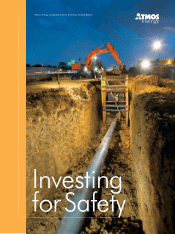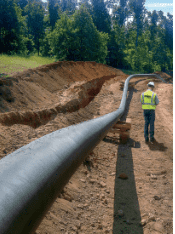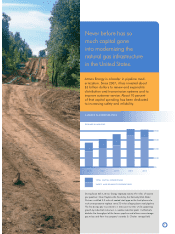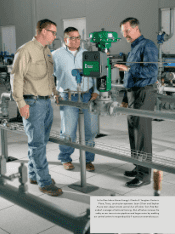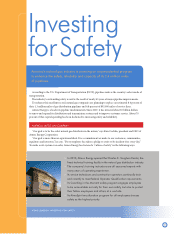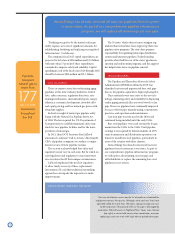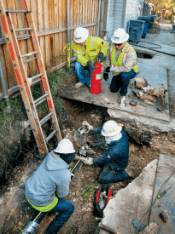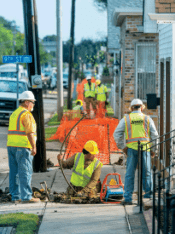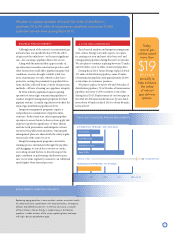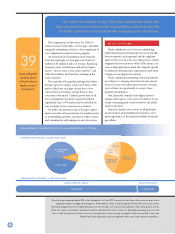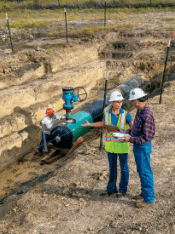Atmos Energy 2014 Annual Report Download - page 10
Download and view the complete annual report
Please find page 10 of the 2014 Atmos Energy annual report below. You can navigate through the pages in the report by either clicking on the pages listed below, or by using the keyword search tool below to find specific information within the annual report.
39
STATES
have adopted
accelerated
infrastructure
replacement
programs.
No matter the material or age of the pipe, replacement crews take
extra precautions to maintain service to surrounding customers, provide
for traffic control and communicate with emergency and city services.
ATMOS ENERGY CONTINUES TO FOCUS ON MODERNIZING ITS SYSTEM
8
e company has worked since the 1980s to
remove its most vulnerable cast iron pipe, and elimi-
nating the remaining sections is a key component of
our comprehensive infrastructure program.
An American Gas Foundation study found in
2012 that replacing cast iron pipe costs from $1.5
million to $5 million a mile, on average. Replacing
it requires close coordination with all city depart-
ments—streets, water, sewer, police and re—and
with other utilities that have lines running in the
same corridors.
e majority of the pipeline mileage that Atmos
Energy expects to replace is bare steel. Some 4,000
miles of this bare steel pipe do not have a low-
current ow of electricity around them to stop
corrosion of the metal. Cathodic protection on all
new steel pipelines has been required by federal
regulations since 1970, and it must be installed on
bare steel pipe if any corrosion is ever found.
No matter the material or age of the pipe, replace-
ment crews take extra precautions to maintain service
to surrounding customers, provide for trac control
and communicate with emergency and city services.
PAYING FOR PROGRESS
Under traditional cost-of-service ratemaking,
utility infrastructure investments are recovered aer
the investment is in the ground and the regulator
approves the costs in a rate case. is process, which
originated in the early years of the 20th century, can
cause a long lag between when the company spends
its dollars for infrastructure replacements and when
it begins recovering the investment.
Under traditional ratemaking, when investments
are subject to a long lag time from the investment
to the recovery, the utility must bear the carrying
costs without an opportunity to recover these
prudent expenditures.
at ultimately translates into higher interest
charges and requires a rate case to be led each year,
a time-consuming and costly activity for the utility
and its customers.
erefore, timely cost recovery of all prudently
incurred safety and reliability investments is of ut-
most importance to the nancial stability of natural
gas utilities.
Atmos Energy inspected about 800 miles of pipelines in fiscal 2014 to ensure their fitness for service as part of our
ongoing integrity management programs. Near Manor, Texas, Project Engineer Tatiana Perry discusses with a
contractor preparations for a hydrostatic pressure test of a 30-inch transmission pipeline. After sealing off a section
of the line, water is pumped in and pressurized to well above the line’s maximum allowable operating pressure and
then is held at that pressure for a minimum of eight hours. Stress testing the pipeline helps assure that it can meet
federal and state regulations and can operate safely even under extreme conditions.
ATMOS PIPELINE–TEXAS UTILITY DIVISIONS
TRANSMISSION PIPELINES: 6,600 TOTAL MILES
DISTRIBUTION PIPELINES: 67,000 TOTAL MILES
5,600 MILES 1,000 MILES
POLYETHYLENE
PLASTIC
˜10%
COATED STEEL
PROTECTED
BARE STEEL
CAST
IRON
PLASTIC
UNPROTECTED
BARE STEEL

